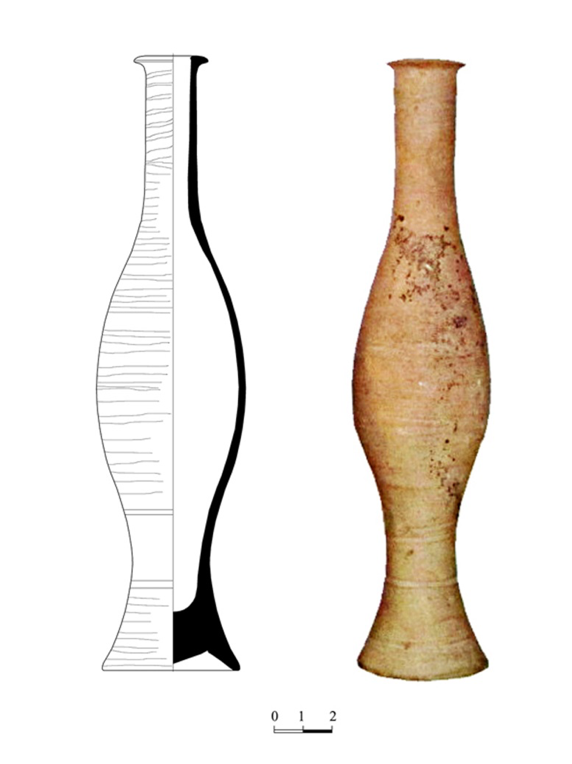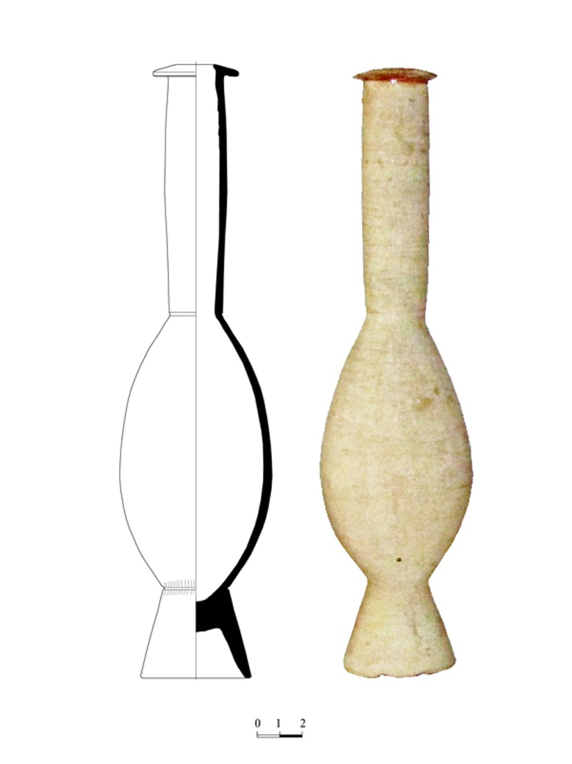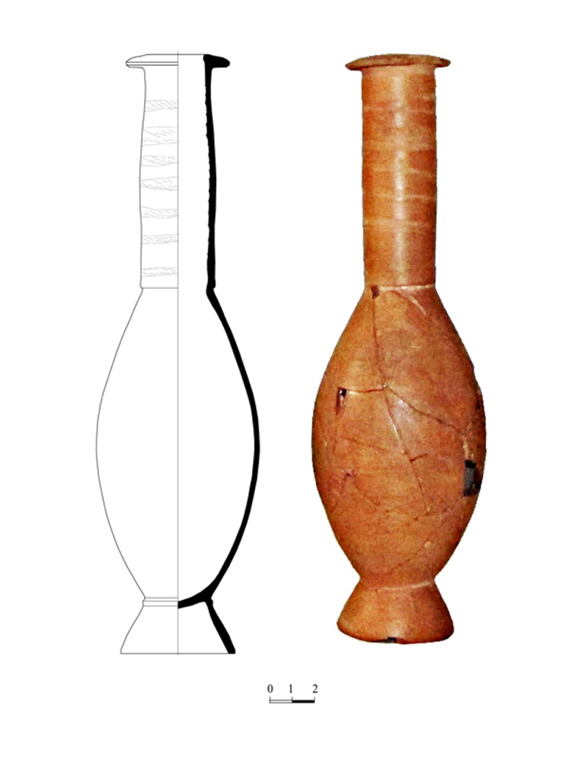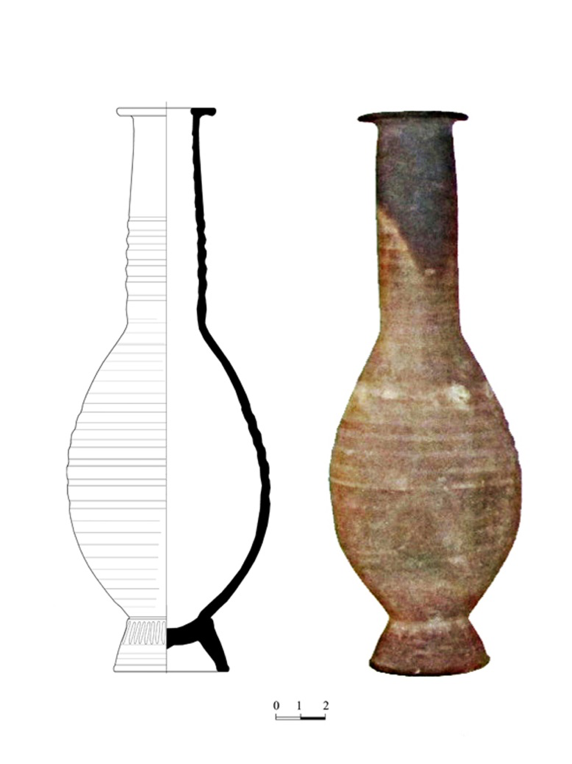Clay Unguentaria from Urbnisi
Introduction
In Kareli district, in 12 km from Gori, on the left bank of the river Kura is located village Urbnisi, where from 1953 to 1963 more than 270 graves and 24 grave remains were discovered. They dated back to different periods. However, most of the burials discovered in section XXV were assigned to the Late Antique Period [Koridze, 1965:1].
Due to their unusual design not characteristic of the 1st-3rd centuries AD, the spindle-shape clay unguentaria attracted a special attention. The vessels were typologically similar, but differed according to the fabric of the clay. The construction of the graves (N 136, 205, 230, 245) was the same: a deceased was buried in a grave-pit bounded with wooden logs. Only in one case, the child’s grave N 136 was plastered with the pit. Due to the damaged skeleton, it was impossible to identify the pose of the deceased.
Graves and Materials
The grave N 136 was discovered 2.3 m under the grave N 127, in the northeast part of the trench. The skeleton was oriented from the east to the west. The unguentarium (pl.1; inv. N 1-60:2853) was found at the pelvis and was the only finding of the child's burial [Koridze, 1965:42]. The spindle-shape unguentarium is made from a pink clay. It has a profiled rim. The neck continues into the ellipse-shape body, which ends with the tall shaped foot. The basement has the knob in the center. Around the foot, the groove is added. On the whole surface of the vessel, the traces of a wheel-mark are visible. The height of the vessel is 21 cm. The diameters of the rim, the body and the base are 2.8 cm, 5.4 cm and 4.6 cm respectively.
 .
.
1
The similar unguentarium was discovered in Greece (on Athenian Agora) in the grave of the Hellenistic period. According to its proportional body shape, it dates back to the 3rd-2nd centuries B.C. [Anderson-Stojanović, 1987:109].
The grave N 245 was found in 1.4 m under the grave N 242, in the central part of the trench VI. The skeleton was oriented from the northeast to the southwest.
The unguentaria were discovered in the grave. One of them was made of clay, while other three were made from glass with a blowing technique.
The spindle-shape unguentarium was found (pl.2; inv. N 1-62:3978) at the right hand of the skeleton. It is made of a reddish clay. It has the opened rim and the tall neck. The ellipse-shape body is widened in the lower part and is set on the high foot. The surface of the vessel is covered with the diagonal concentric lines. The inner side of the neck is covered with engobe, while the outer side of the body is polished. The height is 19 cm. The diameters of the rim, the neck, the body and the base are 3.7 cm, 2.7 cm, 6 cm and 4 cm respectively.

2
The glass vessels found in the grave N 245 date back to the 1st-2nd centuries AD [Saginashvili, 1970:75-76, 85; cat. NN135, 140, 189].
The grave N 205 was found in the east part of the trench IV, at the depth of 1.8 m. In the burial, the east-west oriented skeleton and two clay unguentaria were found. One of them (pl.3; inv. N1-62:3722) was put parallel to the shin of the skeleton. It is made of almost whitely burnt clay. The rim is profiled and flatted. The neck is high. The body has the form of an elongated ellipse. The foot is high and deep. The wheel-marks are visible on the vessel. The remains of a red paint is preserved on the inner side of the neck, on the surface and randomly on the body. The height is 24.8 cm. The diameters of the rim, the body and the base are 3.7cm, 7 cm and 4.8 cm respectively.

3
The second clay unguentarium (pl.4; inv. N1-62:3723) was placed along the legs. It is red-fired and polished. The rim is profiled. The neck is high and cylindrical. The body has the form of an ellipse. The foot has the form of a cut cone. The neck is separated from the body via the slightly seen gutter. The remains of a dark paint are preserved on the rim. The body is incomplete, but restored. The height of the vessel is 24.4 cm. The height of foot is 2.5 cm. The diameters of the body and the rim are 7.4 cm and 4.5 cm respectively. The high foot is 5 cm in diameter.

4
Two glass unguentaria were found together with the deceased. One of them (inv. N1-62:3724) is made by a blowing technique and decorated with vertical cannelures. It is considered as Syrian import and dates back to the 1st century AD [Saginashvili, 1970:12, 50, cat. N4]. Glass vessels found in this grave and made by a blowing technique were dated back to the 1st-2nd centuries AD by Saginashvili [Saginahshvili, 1970:74, cat.N132]. This date is supported by the glyptic data, especially, the intaglio with the image of goddess Nike and attributes of Athena and Fortune [Javakhishvili, 1972:35].
The deceased was accompanied by materials made from bronze: fragments of the lamellated object (inv. N1-62:3727), the object with sharp, flattened and triangular end (inv. N1-62:3728), the mirror with fragments of a lead handle (inv. N1-62:3726) and miniature bells (inv. N1-62:3729). One of them has the shape of a cone, while other two have rounded tops. The rest of the materials of the grave comprise the jet polychrome glass, bronze as well as crystal beads and pendants (inv. N1-62:3733).
The grave N 230 was found in the middle of trench V at the depth of 1.7 m. It was oriented from the east to the west. Twenty-three flasks were discovered in the grave. One was made of clay, while others were made from glass.
The clay flask (pl.5; inv. N1-62:3879) was found along the mid part of the left thigh. It is made of a brown-fired clay with reddish and black spots on the surface. The profiled rim is opened. It has a tall neck, an oval-shaped body and a high-deepened foot. The narrow round grooves are visible on the neck and shoulders. The height is 22.5 cm. The diameters of the rim and the base are 4.1 and 4.6 respectively.

5
The form-blown and free-blown glass vessels were found in the grave N 230. Most of them are very small. The brownish double handle glass amphoriskos (inv. N1-62:3897) dates back to the second half of the first century AD [Saginahsvili, 1970:49, cat. N2; 4,156; 7, 57, fig. XLI, 5]. The glass bottle (fig. VI 2, inv. N1-62:3890) was found in the same grave. One part of archaeologists date similar vessels back to the 1st - 2nd centuries AD [Fleming, 1999:62], the other group places them within the frames of the 2nd century AD [Vanderhoeven, 1961:65, pl. XV]. However, Saginashvili indicates to its earlier origin according to the materials found in the grave [Saginashvili, 1970:19]. The glyptic finds of the grave, such as the garnet intaglio in the silver ring (inv. N1077a), the cornalian intaglio in the bronze ring with the image of the running dog (inv. N1076), the cornelian intaglio in the iron ring with the image of the hand shaking (inv. N1078) and the cornelian intaglio in the iron ring with the image of Athena (inv. N1075) correspond to the vessel date and date back to the 1st-2nd centuries A.D. [Javakhishvili, 1972:33-34].
The deceased was accompanied with the iron ring (inv. N1-1962:3922) and the four-faceted awl (inv. N1-1962:3906) as well as the following objects made from bronze: the double bejeweled ring (inv. N1-62:3904), the pendants (inv. NN1-1962:3907, 1-1962:3908), the spoon (inv. N1-1962:3909), the chain, which has glass beads covered with gold (inv. N1-1962:3919), the mirror and small bells, the fragments of the bone object (inv. N1-1962:3921), the agate, jet, cornelian, glass, crystal and faience bead pendants, the beads (inv. N 1-1962:3920), which were probably fixed to the leather (among them are the sandwich-gold glass beads) and sea shells (inv. N1-1962:3923).
Small bells are one of the most spread artifacts of the sites of the classical period. Among the small bells found in the grave N 230, three were made of silver (inv. N1-1962:3914) and two were put on the bronze bracelet. Besides the above-mentioned items, the conical, dome shaped and open-work filigree small bells were also discovered (inv. NN1-62:3915, 1-1962:3916, 1-1962:3917, 1-1962:3918).
In the grave N 230 the Egyptian faience amphora-pendant was discovered (inv. N1-62:3910) among other beads. It belongs to the 82nd type of the classification by E. Alekseeva and it is quite frequent in the graves, which date back to the 1st century B.C. – 2nd century A.D. [Alekseeva, 1975:46]. The similar items were found on Dedoplis Gora, which dates back to the 1st century A.D. [Gogiberidze, 1999:106-114]. The polychromous beads made in a mosaic technique are included in the type 415 and date back to the 1st century B.C. – the 2nd century A.D. [Alekseeva, 1982:38, fig. 48 (16, 17)]. This date is supported by the presence of the beads found here. They have a yellow star on a green background and a red circle in the center of the star. These beads belong to the 485th type of the same classification [Alekseeva, 1982:43, fig. 49; 4, 5]. Thus, all parallels of these materials date back to the 1st century B.C. – the 1st century A.D.
The crystal pendant (inv. N1-1962:3911) found in the same grave is quite interesting. It is put in the grid made from bronze stems, which are interwoven in the upper part and create the ring. Relatively earlier similar types of the pendants are also known [Максимова 1962:226-230]. The analogue of the pendant found in Urbnisi was discovered on Dedoplis Gora and dates back to the 1st century A.D. [Gogiberidze 2008, cat. N94]. Therefore, according to the context of the grave, the end of the 1st century A.D. can be its reasonable date.
Conclusions
The discussion of the graves showed that the unguentarium is a necessary attribute of a funeral ritual. In the burial N 136 unguentarium is the only finding, in the grave N 245 all four objects are unguentaria (1 clay, 3 glass), in the burial N 205 four items from 12 are unguentaria and in the grave N 230 twenty-three objects from 44 are unguentaria (1 clay, 22 glass).
According to the typological-chronological classification of the clay unguentaria, the vessels of the 5th-2nd centuries B.C. have the feet separated from the wide bodies, while the unguentaria, which date back to the 1st century B.C. – the 3rd century A.D. have the pear-shaped lower parts and flat bases. They are made similarly to glass vessels [Alekseeva, 1982:105-122]. The unguentaria from Urbnisi have distinguished forms and they do not fit any group of the above-mentioned classification. The most close and contemporaneous site of Urbnisi is Dedoplis Gora, where unguentaria have flat bases and do not look like those from Urbnisi [Chanishvili, 2008:77-80].
The clay flask found in the grave N 136 (pl. 1) looks like the items found in Vani, which date back to the 2nd century B.C. However, the bases of the vessels from Vani are narrower [Tolordava, 1983:75-76, cat. N378]. It seems that the vessels with their typological features have intermediate shapes and connect Hellenistic unguentaria to Urbnisi ones. No other materials were found in the grave. We can suppose that it was made after the 2nd century B.C. and is the earliest one among unguentaria from Urbnisi. Moreover, the graves containing clay flasks could belong to the earliest group of the cemetery, since the unguentaria of the same type continue the Hellenistic tradition of production.
As for the origin of the vessels, their analogues have not been found yet. The typological similarity and difference of the clay fabric enable us to suppose that they were produced in various centers. It is noteworthy that D. Koridze supposed their local origin [Koridze, 1965:52-53].
Thus, the above-discussed burial complexes can date back to the 1st century B.C. – the 1st century A.D.
References
| Saginashvili M. 1970 |
Glass vessels of Urbnisi Cemetery. Tbilisi: Metsniereba. |
| Tolordava V. 1983 |
Clay unguentaria. Vani VII. Tbilisi. |
| Vanderhoeven M. 1961 |
Verres Romains (I-er 3-me siècle). Journèes Internationales du Verre. N 69. Liége. |
| Максимова М. И. 1962 |
Амулет из Горгиппии и так называемые «шарики-подвески».Советская археология. N2. Академия наук СССР. Москва. |
| Anderson-Stojanović V. R. 1987 |
The chronology and function of ceramic unguentaria. American Journal of Archaeology. Vol. 91. N1. Boston. |
| Chanisvili T. 2008 |
Iberia and Rome. The excavations of the palace at Dedoplis Gora and the Roman influence in the Caucasian kingdom of Iberia. Langenweißbach |
| Fleming S.J. 1999 |
Roman glass, reflections on cultural change. University of Pennsylvania Museum of Archaeology and Anthropology. Philadelphia. |
| Jinjikhashvili G. 1980 |
The 1st BC-1st AD Pithos graves from Sakaraulo Seri Cemetery. Tbilisi. |
| Javakhishvili K. 1972 |
Glyptic of Urbnisi Town. Tbilisi: Metsniereba. |
| Koridze D. 1965 |
For the periodization of Late Antic sites found at Urbnisi Cemetery (Manuscript). Tbilisi. |
| Sagnishvili M. 1982 |
Accidental finds glass vessels from Urbnisi.Review of State Museum of Georgia XXXVI-B. Tbilisi. |
| Алексеева Е. М. 1975 |
Античные бусы Северного Причерноморья. Археология СССР. Свод археологических источников. вып. Г1-12. Москва: Наука. |













